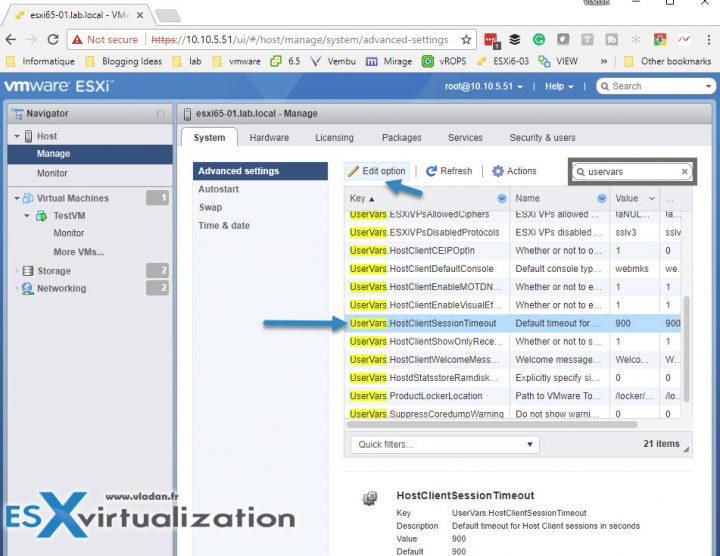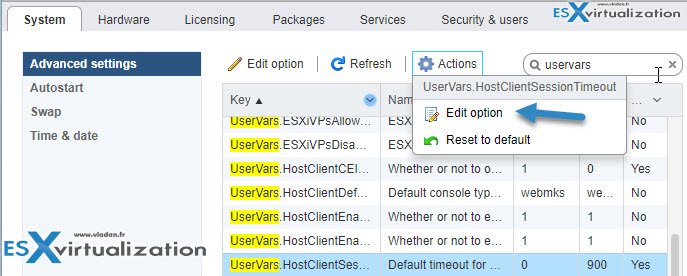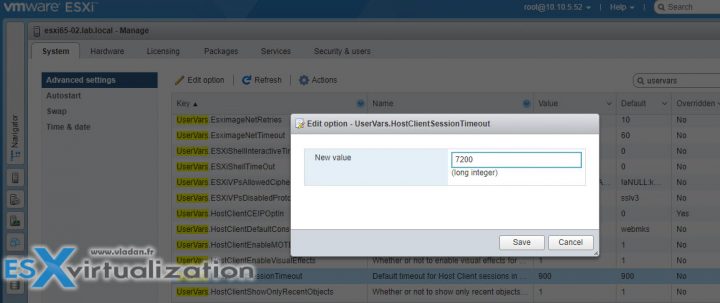One of the challenges when working with individual ESXi hosts not managed via vCenter server might be the Inactivity timeout interval. VMware ESXi host client has a default inactivity interval pretty low so after 15 minutes of inactivity you'll find yourself locked out and you have to reidentify again.
There is a simple way of changing this value. Today we will show you how to Increase Inactivity Timeout on VMware ESXi Host Client via the GUI. There is a way of doing it via CLI but it is not the subject of today's article.
The default value is 900 (in seconds), which is 15 minutes, but we can change that to something more. Let's say 2 hours, which would be 7200 seconds. Well, this is also the maximum value which we can change to. Unless we put zero (yes “0”) as a value. And in this case, the timeout inactivity would be disabled on our ESXi host.
This is something that you would not like to have in a production environment, right? I'd prefer to enter some higher value, let's say 8 hours which means if I connect once when I came to the office, in the morning, so I stay connected the whole day without being logged off every 2 hours.
If you're working with vCenter server and you have deployed VMware vCenter Server Appliance (VCSA) you might be interested in a similar article we have written a few months back – How To Disable vSphere Web Client Inactivity Timeout. (note that it is not recommended to disable completely the value).
Let's get started.
Increase Inactivity Timeout on VMware ESXi Host Client – The steps
Connect to your VMware ESXi host via your web browser. Go to
https://IP_of_ESXi/ui
And then Select your Host > Manage > System TAB > Advanced Settings.
Either type “uservars” and select the UserVars.HostClient.SessionTimeout > Edit option or
Do a Right-click on UserVars.HostClient.SessionTimeout and then select “Edit option.” You'll be able to change the value there.
And finally, you can enter the new value. For production environments, you should enter the maximum allowed value which is 7200.
You do not have to reboot the host for this change to take effect. Some VMware KB mentions that
You must restart the SSH service and the ESXi Shell service for the timeout to take effect.
This is it. We have successfully changed the value and Increased Inactivity Timeout on our VMware ESXi Host Client. We have a lab environment where we can put zero (0) values so we will never get a logoff message.
Let's explore a bit further.
If you have time to explore a bit further you would notice that the “uservars” gives you other options as well. Let's have a look what else can be changed. For example:
UserVars.DcuiTimeOut – this value is a value which works together with host client timeout value as this value shows how long before you're logged off, ESXi displays you a message telling you that you'll be logged off in a couple of mins….
An idle time in seconds before DCUI is automatically logged out. Setting 0 disables the timeout.
So if you disable this setting AND keep the default setting for the Inactivity Timeout, you will be kicked out without notice….
The notice shows in the status bar of your browser…..
UserVars.HostClientCEIPOptIn – allows you to change the CEIP (VMware Customer Experience Program). While you may change the settings there to “0”, do you know what are the benefits of this program? Check my detailed article – What is VMware CEIP Program And How It Helps An IT Admin With Troubleshooting vSphere.
UserVars.ESXiShellTimeOut – Time before automatically disabling local and remote shell access (in seconds, 0 disables). Takes effect after the services are restarted
UserVars.ESXiShellInteractiveTimeOut – Idle time before an interactive shell is automatically logged out (in seconds, 0 disables). Takes effect only for newly logged in sessions.
UserVars.DcuiTimeOut – This is a Direct Console User Interface (DCUI). Whether you're in the server room (or also via Putty remote console by typing “DCUI).
Closing words:
While this setting is on “per-ESXi” host so each individual ESXi host would have to be changed, vCenter server environments managed via vSphere Web client are not concerned. As being said, for production environments, I'd stay within the recommended (and allowed) values which is 7200 seconds maxi. But if you're just runningn a lab, you can simply put “0” and have your session openned forever, or at least unless you reboot your host…
VMware
More from ESX Virtualization:
- How To Reset ESXi Root Password via Microsoft AD
- How to Configure Statistics Collection Intervals in vCenter
- How to reset ESXi 6.x root password and under which conditions
- VMware HCL for ESXi
- How to Install latest ESXi VMware Patch – [Guide]
Stay tuned through RSS, and social media channels (Twitter, FB, YouTube)




